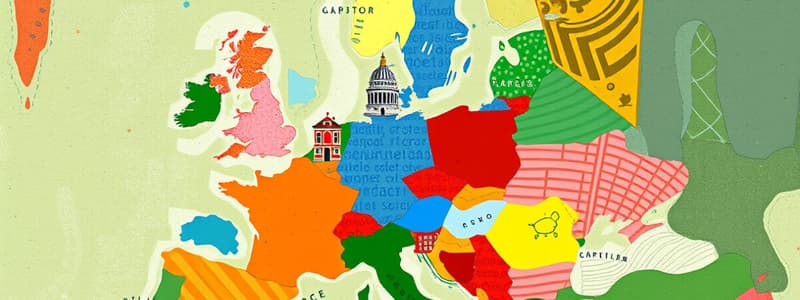Podcast
Questions and Answers
Which capital is located along the Seine River?
Which capital is located along the Seine River?
- Rome, Italy
- Budapest, Hungary
- Stockholm, Sweden
- Paris, France (correct)
What geographical feature significantly influences the location of many European capitals?
What geographical feature significantly influences the location of many European capitals?
- Plateaus
- Volcanoes
- Deserts
- Mountain ranges (correct)
Which city is situated on the River Thames?
Which city is situated on the River Thames?
- Warsaw, Poland
- Oslo, Norway
- Madrid, Spain
- London, United Kingdom (correct)
Which capital city is known for its division by the Danube River?
Which capital city is known for its division by the Danube River?
What type of climate is predominantly found in many coastal capitals?
What type of climate is predominantly found in many coastal capitals?
Which capital is known for its historical significance in music and politics?
Which capital is known for its historical significance in music and politics?
Which city is characterized by being spread across 14 islands?
Which city is characterized by being spread across 14 islands?
Which capital has a central geographical location on the Iberian Peninsula?
Which capital has a central geographical location on the Iberian Peninsula?
What impact do nearby natural resources have on some European capitals?
What impact do nearby natural resources have on some European capitals?
Which city is recognized as a major political and cultural center in Central Europe?
Which city is recognized as a major political and cultural center in Central Europe?
Flashcards are hidden until you start studying
Study Notes
Geography of European Capitals
-
Location and Distribution
- Europe is divided into several regions, each with its own capitals.
- Capitals are often situated in strategic geographical locations, such as central positions, near rivers, or along trade routes.
-
Northern Europe
- Oslo, Norway: Coastal city with fjords.
- Stockholm, Sweden: Spread across 14 islands, connected by bridges.
-
Western Europe
- London, United Kingdom: Located on the River Thames, historical significance in trade.
- Paris, France: Situated on the Seine River, a cultural and political hub.
-
Southern Europe
- Rome, Italy: Located inland, rich in historical significance; part of the Italian peninsula.
- Madrid, Spain: Central location; high elevation in the Iberian Peninsula.
-
Eastern Europe
- Warsaw, Poland: Central location, rebuilt post-WWII; along the Vistula River.
- Budapest, Hungary: Divided by the Danube River into Buda and Pest.
-
Central Europe
- Berlin, Germany: Major political and cultural center; has significant historical landmarks.
- Vienna, Austria: Located near the borders of several countries; historically significant in music and politics.
-
Landforms and Climate
- Many capitals are influenced by nearby mountains, rivers, and seas.
- Maritime climates are common in coastal capitals, while continental climates are more prevalent inland.
-
Accessibility
- Many capitals are hubs for transportation, including air, rail, and road networks.
- Proximity to trade routes can influence economic activities and population density.
-
Natural Resources
- Some capitals are near natural resources, impacting their development and economic focus (e.g., oil in Vienna).
-
Urban Planning
- Capitals often feature planned urban centers with historical sites, parks, and governmental buildings, reflecting their importance.
Understanding the geographical context of European capitals provides insight into their historical development, cultural significance, and economic viability.
Location and Distribution
- Europe comprises various regions, each with distinct capitals strategically located for trade, transportation, and cultural significance.
- Capitals are frequently positioned in central areas, near rivers, or along important trade routes.
Northern Europe
- Oslo, Norway: A coastal city known for its fjords.
- Stockholm, Sweden: Unique for its spread across 14 islands, interconnected by bridges.
Western Europe
- London, United Kingdom: Key trade city situated on the River Thames; historically significant.
- Paris, France: Located on the Seine River, recognized as a cultural and political hub.
Southern Europe
- Rome, Italy: Inland capital known for its historical richness; integral part of the Italian peninsula.
- Madrid, Spain: Positioned centrally with high elevation on the Iberian Peninsula.
Eastern Europe
- Warsaw, Poland: Central location; significantly rebuilt after WWII and located along the Vistula River.
- Budapest, Hungary: Split by the Danube River, consisting of Buda and Pest.
Central Europe
- Berlin, Germany: Political and cultural core of Europe with significant historical landmarks.
- Vienna, Austria: Close to several country borders, historically vital in music and politics.
Landforms and Climate
- Capital cities are often shaped by nearby mountains, rivers, and coastal areas.
- Coastal capitals typically experience maritime climates, while inland cities usually have continental climates.
Accessibility
- European capitals serve as major transportation hubs, integrating air, rail, and road networks.
- Proximity to trade routes enhances economic activities and influences population densities.
Natural Resources
- Some capitals’ development and economic focus are influenced by nearby natural resources, such as oil in Vienna.
Urban Planning
- Capital cities often include planned urban areas with historic sites, parks, and government buildings, underscoring their significance.
- Understanding the geographical context of these capitals reveals insights into their historical development, cultural roles, and economic prospects.
Studying That Suits You
Use AI to generate personalized quizzes and flashcards to suit your learning preferences.




